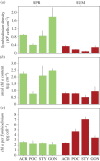Functional significance of dinitrogen fixation in sustaining coral productivity under oligotrophic conditions
- PMID: 26511052
- PMCID: PMC4650168
- DOI: 10.1098/rspb.2015.2257
Functional significance of dinitrogen fixation in sustaining coral productivity under oligotrophic conditions
Abstract
Functional traits define species by their ecological role in the ecosystem. Animals themselves are host-microbe ecosystems (holobionts), and the application of ecophysiological approaches can help to understand their functioning. In hard coral holobionts, communities of dinitrogen (N2)-fixing prokaryotes (diazotrophs) may contribute a functional trait by providing bioavailable nitrogen (N) that could sustain coral productivity under oligotrophic conditions. This study quantified N2 fixation by diazotrophs associated with four genera of hermatypic corals on a northern Red Sea fringing reef exposed to high seasonality. We found N2 fixation activity to be 5- to 10-fold higher in summer, when inorganic nutrient concentrations were lowest and water temperature and light availability highest. Concurrently, coral gross primary productivity remained stable despite lower Symbiodinium densities and tissue chlorophyll a contents. In contrast, chlorophyll a content per Symbiodinium cell increased from spring to summer, suggesting that algal cells overcame limitation of N, an essential element for chlorophyll synthesis. In fact, N2 fixation was positively correlated with coral productivity in summer, when its contribution was estimated to meet 11% of the Symbiodinium N requirements. These results provide evidence of an important functional role of diazotrophs in sustaining coral productivity when alternative external N sources are scarce.
Keywords: Symbiodinium; diazotrophs; hermatypic corals; nitrogen fixation; organic matter release; photosynthesis.
© 2015 The Author(s).
Figures




References
-
- Moberg F, Folke C. 1999. Ecological goods and services of coral reef ecosystems. Ecol. Econ. 29, 215–233. (10.1016/S0921-8009(99)00009-9) - DOI
-
- Wild C, et al. 2011. Climate change impedes scleractinian corals as primary reef ecosystem engineers. Mar. Freshw. Res. 62, 205–215. (10.1071/mf10254) - DOI
-
- Stambler N. 2011. Zooxanthellae: the yellow symbionts inside animals. In Coral reefs: an ecosystem in transition (eds Dubinsky Z, Stambler N), pp. 87–106. Amsterdam, The Netherlands: Springer.
-
- Dubinsky Z, Jokiel PL. 1994. Ratio of energy and nutrient fluxes regulates symbiosis between zooxanthellae and corals. Pac. Sci. 48, 313–324.
Publication types
MeSH terms
Substances
LinkOut - more resources
Full Text Sources
Other Literature Sources

